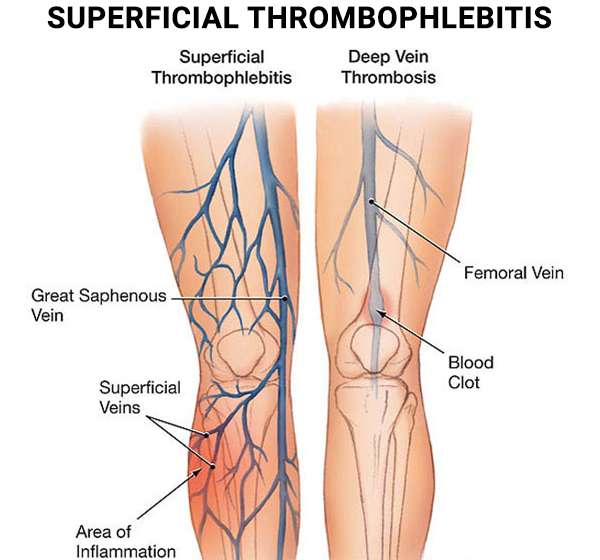

Superficial thrombophlebitis, referred to as ST, is a relatively easy condition to treat, very often with minimal lifestyle changes and a careful follow-up with a vein specialist. The blood clot causing the pain may be reduced so that you don’t end up needing further interventions. If left untreated, ST can turn into a deep vein thrombosis (DVT) that can become life-threatening. Don’t take chances with your life or your blood vessels. Call one of the experienced vein doctors at the Vein Care Center, with convenient hours and locations throughout New York City and New Jersey.
Superficial thrombophlebitis (ST) is a condition caused by an inflammation in a vein just beneath the skin because of a blood clot. This is a common condition affecting the legs, but can also affect the arms or neck. Unlike a deep vein thrombosis, the risk of the blood clot reaching the lungs is much lower.
Superficial veins play a critical role in the circulatory system. They help transport blood back to the heart and lungs for re-oxygenation. These veins also help cool the body in response to the environment with blood from deep veins. The blood clots that lead to thrombophlebitis cause inflammation of the blood vessels, leading to pain, swelling and other uncomfortable symptoms.
Visit the Vein Care Clinic, with offices in Greenwich Village, Midtown Manhattan, Upper East Side, and the Financial District in New York City, as well as in East Brunswick, Englewood Cliffs, Paramus, Riverdale, and Cranford in New Jersey. Their experienced vein doctors, led by Dr. Jonathan Arad use advanced medical technology for the diagnosis and treatment of venous diseases and multiple vein conditions, including ST.

When there is a blood clot, also referred to as a thrombus, in a superficial vein, the risk of inflammation increases. Doctors diagnose the reaction in the walls of the vein and surrounding tissues as superficial thrombophlebitis also called superficial venous thrombosis. Several factors can lead to the development of ST, including:
The blood clot and inflammation in superficial veins can occur directly because of these factors or they may make a blood clot more likely, increasing the risk. There is also the risk of infection if you had a drip inserted into a vein incorrectly. That is why it is imperative that you seek vein and ST treatment from an expert in vein treatments at the Vein Care Center.
Your experienced vein doctor considers your symptoms of superficial thrombophlebitis, examines your medical history and carries out necessary tests, including a vascular ultrasound, to determine the exact cause of your discomfort. Common symptoms of ST include:
These symptoms point to the development of a blood clot and inflammation of the walls of the affected blood vein. If not treated, the superficial thrombophlebitis can worsen into deep vein thrombosis if the clot moves to the deeper veins.
"Vein Care Center doctors and staff are the best professionals in a medical office. They make the effort and take time to make sure all your questions are answered. Doctor made the procedure smooth and pain free.
Monica S.During your vein consultation, your doctor identifies the underlying cause of your superficial vein inflammation before starting treatment. Extensive diagnosis is critical to form an individualized treatment plan that may include:
Read more:
What to Know About Thrombophlebitis
At the Vein Care Center, the vein specialists use the latest medical technology and approaches for treatment of vein conditions. With the correct diagnosis, the vein specialists offer an individualized treatment plan for better outcomes for treating ST. Contact the nearest office today before you suffer any further consequences.